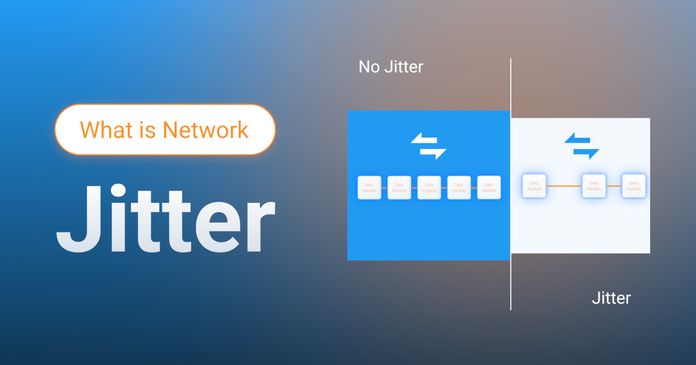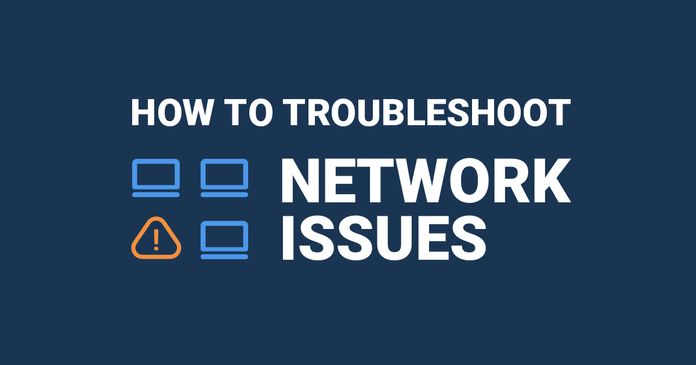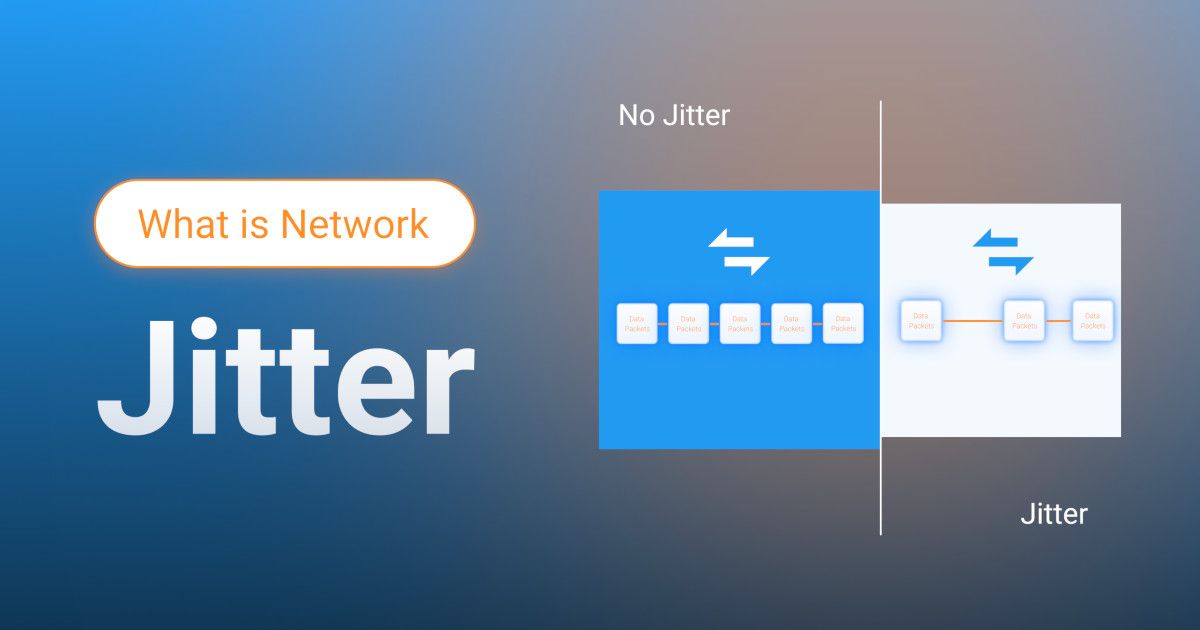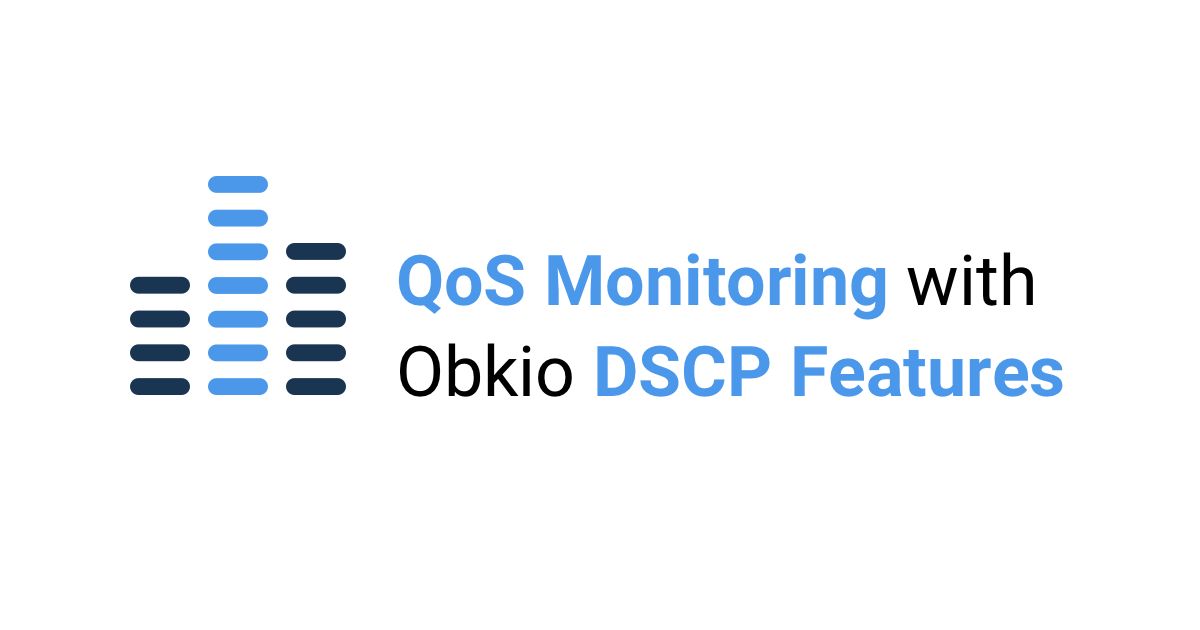Table of Contents
Table of Contents
Businesses rely heavily on their networks to maintain smooth operations, enable seamless communication, and facilitate efficient data transfers. However, network instability can throw a wrench into even the most well-oiled business machinery, resulting in frustrating delays, dropped connections, and reduced productivity. This is where network jitter monitoring comes to the rescue.
Network jitter, the variability in packet delay or latency, is a common culprit behind network instability. It can wreak havoc on real-time applications such as voice and video conferencing, online collaboration tools, and even financial transactions. Identifying and resolving jitter-related issues is crucial for businesses and network administrators alike, ensuring a stable and reliable network environment.
In this blog post, we will delve into the world of network jitter monitoring and explore effective strategies to solve network instability. Whether you're a seasoned network admin looking to optimize your infrastructure or a business owner seeking to improve your network's performance, this guide will equip you with the knowledge and tools necessary to tackle jitter head-on.
By the end of this article, you'll have a solid understanding of network jitter monitoring and the steps you can take to address network instability effectively. With these insights, you'll be better equipped to ensure a reliable, high-performing network that supports your business objectives and enables uninterrupted operations.
So, let's embark on this journey together, as we unravel the mysteries of network jitter monitoring and equip ourselves with the tools to conquer network instability once and for all.
Unravel the mysteries of network jitter! Discover its causes, impacts, and solutions. Tame jitter with Obkio's monitoring tool for smooth network performance.
Learn more

Firstly, let’s all start on the same page.
Network jitter refers to the variation or irregularity in the delay of network packet delivery. In simpler terms, it is the inconsistency in the time it takes for data packets to travel from one point to another in a network. Jitter can affect both wired and wireless networks, and it is typically measured in milliseconds (ms).
Jitter can occur due to several factors, such as congestion, network congestion, routing issues, hardware limitations, or fluctuations in network traffic. It often manifests itself as small, random delays in packet delivery, causing packets to arrive at their destination with different inter-arrival times.
We'll dive more into the causes of network jitter a little later in this article as we tackle the fundamentals of network jitter monitoring, discussing the key metrics and monitoring techniques that provide insights into network stability.

Network jitter can have several impacts on network performance, affecting both user experience and the overall functionality of the network. Here are some key impacts of network jitter:
- Degraded Quality of Service (QoS): Jitter can disrupt real-time applications that require consistent and timely packet delivery, such as voice and video communication. It can result in choppy audio or video, distorted communication dropped frames, and interruptions in real-time interactions. This leads to a degraded Quality of Service and a poor user experience.
- Increased Latency: Jitter introduces additional delays in packet delivery, causing increased latency. Latency refers to the time it takes for data packets to travel from the source to the destination. High jitter levels can result in unpredictable delays, which negatively impact the responsiveness and speed of network connections.
- Packet Loss: In extreme cases, excessive jitter can lead to packet loss. When packets arrive out of order or with significant variations in arrival times, some packets may be discarded to maintain synchronization. Packet loss can significantly impact the integrity and reliability of data transmission, leading to incomplete or distorted information.
- Reduced Network Capacity: Jitter can contribute to network congestion and reduced network capacity. When jitter-related issues occur, network resources may be inefficiently utilized as packets are retransmitted or delayed, leading to decreased overall network performance and throughput.
- Disrupted Real-Time Applications: Real-time applications heavily reliant on low latency, such as online gaming, video conferencing, or streaming services, can be severely affected by jitter. The interruptions and delays caused by jitter can disrupt real-time interactions, causing frustration and hindering productivity.
- Challenges for VoIP and Telephony: Voice over IP (VoIP) and telephony systems are highly sensitive to jitter. It can result in distorted or garbled audio, making it difficult for users to communicate effectively. High jitter levels can also cause call drops or disconnects, leading to communication breakdowns.
- Impact on Network Monitoring and Diagnostics: Jitter can complicate network monitoring and diagnostics efforts. When jitter levels are high, it can be challenging to isolate the root cause of network issues or accurately measure network performance. This can prolong troubleshooting processes and delay problem resolution.
In summary, network jitter has a significant impact on network performance by degrading Quality of Service, increasing latency, causing packet loss, reducing network capacity, disrupting real-time applications, introducing challenges for VoIP and telephony, and complicating network monitoring and diagnostics. Monitoring and managing jitter levels are essential for maintaining a stable and reliable network environment.
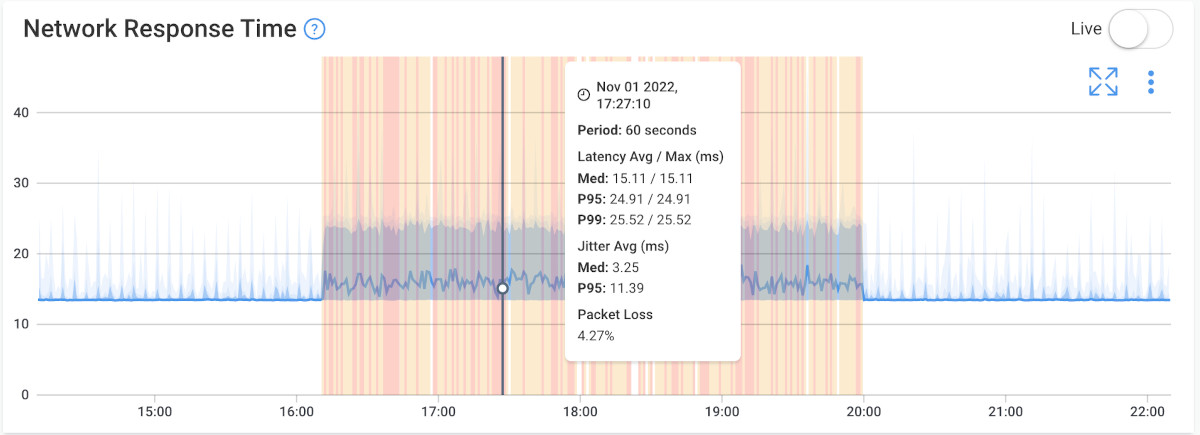

So now that we understand the _unstable _impact that jitter has on your network performance and key applications, it’s clear to see why it’s important to monitor and troubleshoot network jitter - preferably as fast as possible.
Jitter is a disruptive network issue that can audibly manifest as robotic or laggy sounds during communication. However, despite its noticeable impact on user experience, it remains crucial to consistently monitor and measure jitter within your network. By doing so, you can identify the source of jitter and its underlying causes.
The most accurate way to monitor network jitter is by using a tool like Obkio Network Performance Monitoring Software.
Obkio is a network performance monitoring tool that is designed to continuously monitor performance and key metrics like network jitter to help you understand your network performance, and identify and fix network issues.
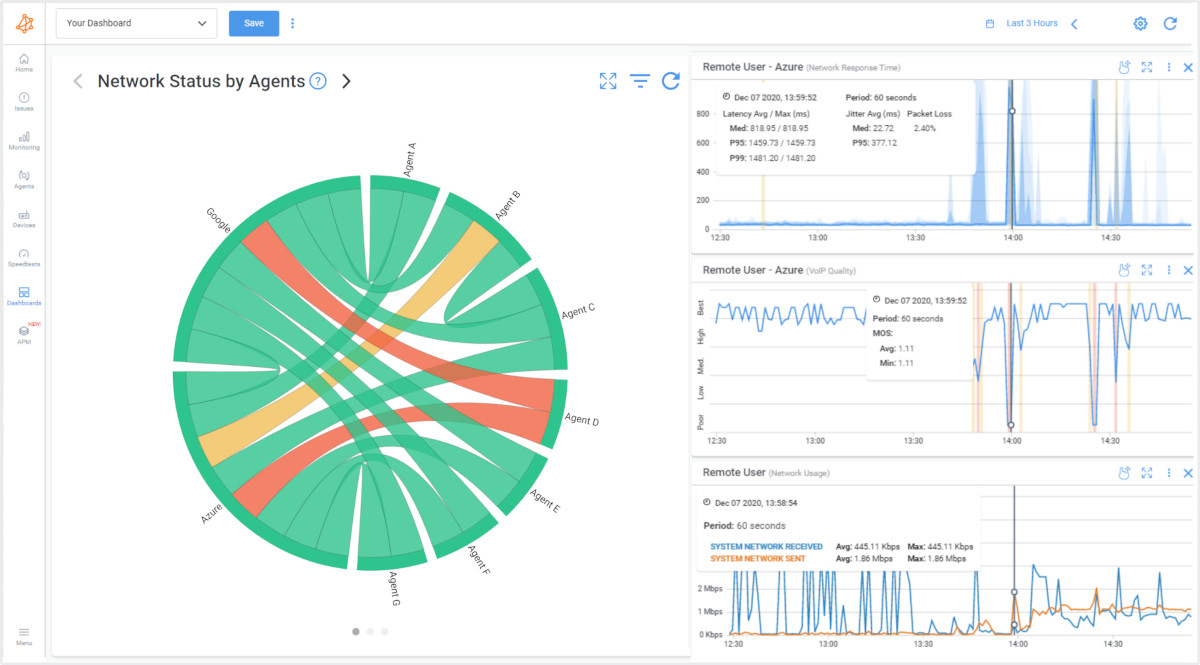
Obkio’s network jitter monitoring feature works by sending synthetic data packets at regular intervals of 500ms (or half a second) to continuously monitor network performance. This is especially critical for monitoring real-time applications, such as voice-over-IP (VoIP) and unified communications (UC), where timing is critical.
By sending packets every 500ms, Obkio can capture any variations in delay or signs of network jitter that may be affecting VoIP or UC applications. This information is then used to calculate the jitter and other metrics that are essential for maintaining optimal network performance.

Network jitter is usually measured in milliseconds (ms), and there are different techniques used to monitor and measure it.
Obkio monitors network jitter using continuous synthetic traffic from Network Monitoring Agents deployed in your most important network locations like offices, data centers and clouds.
For example, you can measure network jitter between your head office and the AWS network, or even between AWS and your data center.
The Agents monitor network jitter in your network by sending and monitoring data packets through your network every 500ms using for the most precise jitter measurements.
There are different methods available for monitoring network jitter measurements. As a complete, synthetic network monitoring tool, Obkio uses a variety of different techniques to monitor jitter and other network performance.
Here is an overview of some commonly used approaches for monitoring and measuring jitter:
- Active Monitoring with Synthetic Traffic: Active monitoring, which is the technique used by Obkio’s app, involves generating synthetic traffic or test packets and monitoring their journey through the network. By tracking the timestamps and measuring the delay between the transmission and reception of these test packets, network jitter can be assessed. Active monitoring provides real-time insights into the current network conditions.
- One-way Delay Measurement: This method involves measuring the delay between the transmission of a packet and its arrival at the destination. By comparing the expected arrival time with the actual arrival time, the one-way delay can be calculated. This approach provides insights into the delay introduced by the network and helps quantify network jitter.
- Round-Trip Time (RTT) Measurement: RTT measurement involves measuring the time it takes for a packet to travel from the source to the destination and back. By sending a packet and recording the time it takes to receive the corresponding acknowledgment, the round-trip time can be calculated. Fluctuations in RTT indicate variations in network jitter.
- Interarrival Time Measurement: This method focuses on measuring the time difference between the arrivals of consecutive packets. By analyzing the interarrival times, the variations or fluctuations between packet arrivals can be determined. Higher variations indicate increased network jitter.
- Statistical Analysis: Statistical techniques can be applied to monitor network jitter measurements. These methods involve collecting a sample of packet delay values over a specific time period and analyzing them using statistical tools like standard deviation, variance, or moving averages. Statistical analysis helps identify trends, patterns, and anomalies in network jitter.
- Passive Monitoring with Flow Analysis: Passive monitoring involves analyzing the flow of network traffic and extracting jitter measurements from the captured data. Flow analysis tools collect and analyze network packets to calculate the delay and variations in packet arrival times. This method provides a comprehensive view of network jitter by examining actual traffic patterns.
The choice of monitoring method depends on factors such as the network infrastructure, available resources, and specific monitoring requirements. Combining multiple methods can provide a more comprehensive understanding of network jitter and help in effectively managing and troubleshooting network performance.


Once you’ve set up Obkio’s Monitoring Agents, they will start monitoring metrics like network jitter and collecting data, which you can easily analyze on Obkio’s Network Response Time Graph.
Identify and monitor network jitter anywhere in your network with updates every minute. You can also set up alerts for when levels of jitter surpass a certain threshold, to identify that network jitter levels are high and you need to do something about it.
Unlike typical monitoring solutions, Obkio offers automatic data aggregation over time, enabling the display of graphs that span a significant period. Through aggregation, Obkio presents the most severe network jitter measurements in the aggregated graph. For instance, when observing a one-hour aggregated period, the displayed network jitter measurement represents the worst median jitter observed within the smaller one-minute periods encompassed by that hour.
This approach is crucial because relying solely on the average network jitter measurement may conceal underlying network issues. Consider a scenario where you examine a 30-day graph and display the average jitter every four hours. Although the average jitter may appear satisfactory, there could be instances of extremely high jitter levels during one of those hours—posing a significant problem, particularly for real-time applications.
In comparison to other monitoring solutions, Obkio emphasizes the presentation of the worst jitter measurements. This approach effectively highlights network issues, identifies their locations, and provides insights into their root causes.
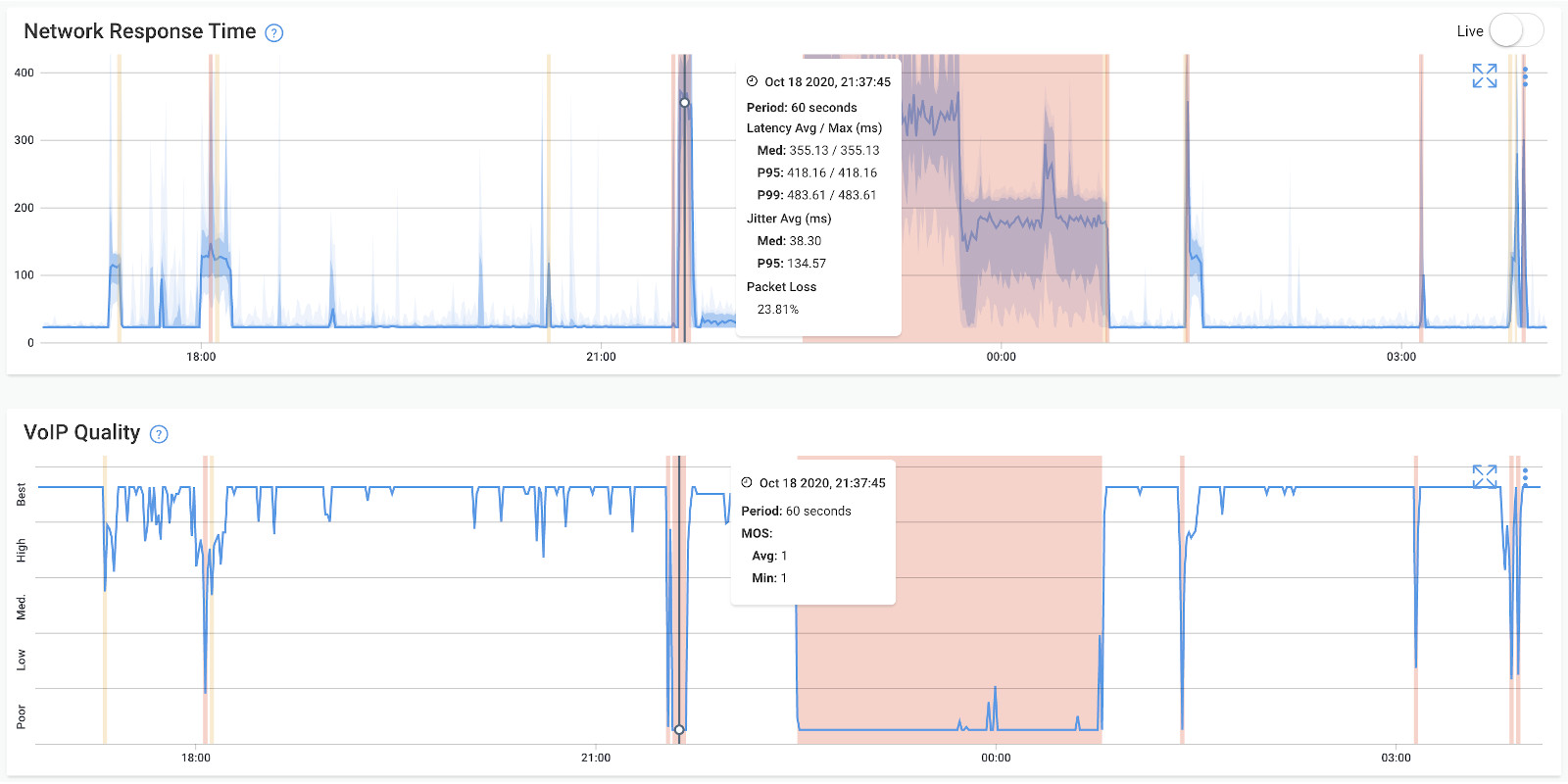
High, low, and acceptable levels of network jitter can vary depending on the specific requirements and characteristics of the application or service being used. However, here are some general guidelines for network jitter levels:
In an ideal network environment, low jitter levels are desirable. Typically, a low jitter level is considered to be in the range of 1-5 milliseconds (ms). Networks with low jitter provide consistent and predictable packet delivery, ensuring smooth communication and minimal disruption for real-time applications.
Acceptable jitter levels can vary depending on the application or service being used. In most cases, jitter levels up to 20 ms are considered acceptable for general-purpose applications and services. While there may be some minor variations in packet arrival times, they do not significantly impact the user experience or the functionality of the application.
High jitter levels can cause noticeable disruptions and degrade the performance of real-time applications. Typically, jitter levels above 20 ms are considered high. In such scenarios, users may experience choppy audio or video, delays in communication, dropped frames, or intermittent connectivity issues. High jitter can severely impact the quality of service for real-time applications.
Jitter can have varying impacts on different applications, depending on their specific requirements and sensitivity to timing. When using a comprehensive end-to-end monitoring solution like Obkio, you gain visibility into all aspects of your network, including locations, devices, and applications. This visibility enables you to monitor how network jitter is affecting different segments of your network infrastructure and individual applications.
Here's an overview of how varying levels of network jitter can affect various types of applications and services:
Real-time communication applications such as voice-over IP (VoIP) calls, video conferencing, and live streaming are highly sensitive to network jitter. Even small amounts of jitter can cause disruptions, leading to choppy audio or video, delayed transmission, and communication gaps. Higher levels of jitter can result in increased packet loss and further degrade the quality of real-time communication.
Video streaming services, such as Netflix or YouTube, require a stable and uninterrupted network connection to deliver high-quality video content. Network jitter can cause buffering, interruptions, and fluctuations in video quality. Users may experience buffering delays, sudden changes in resolution, or even temporary freezing of the video stream.
Cloud-based applications, including software-as-a-service (SaaS) platforms and cloud storage services, rely on reliable and responsive network connections. Network jitter can impact the performance of these applications, resulting in slower response times, reduced productivity, and potential data transfer issues. Users may experience delays in accessing files, saving changes, or interacting with cloud-based software.
Network jitter can have implications for financial transactions conducted online. When performing online banking, stock trading, or other financial transactions, the accuracy and integrity of data are critical. Higher levels of jitter can lead to delays in transaction processing, synchronization issues, and potential errors in financial calculations or confirmations. This is especially important for platforms using loan service software, where precise data exchange is required to ensure accurate loan approvals, interest calculations, and payment processing.
Internet of Things (IoT) devices and industrial control systems often rely on low-latency and reliable network connections. Network jitter can disrupt the communication between IoT devices, leading to delays in data collection, command execution, or real-time monitoring. In industrial settings, increased jitter levels can impact the performance and coordination of control systems, potentially affecting production processes or safety protocols.
Online gaming relies on low latency and consistent network performance to provide a smooth and responsive gaming experience. Network jitter can introduce delays and inconsistencies, causing players to experience lag, input delay, and synchronization issues. Higher levels of jitter can lead to frustrating gameplay, missed opportunities, and a degraded gaming experience.
Learn how to measure VoIP Quality using MOS Score (Mean Opinion Score) & Obkio’s VoIP monitoring solution to identify poor VoIP Quality issues & dropped calls.
Learn more

So once you know that your network is in fact being infested by the jitterbug, you need to know what’s causing it. Network jitter can be caused by various factors, and identifying them may not be immediately apparent. A crucial aspect of monitoring network jitter is gaining an understanding of the root causes behind high levels of jitter in your network and implementing effective solutions.
With Obkio, you can further drill down to identify where exactly the network jitter is happening, and start troubleshooting at the source.
Network jitter can be caused by several factors, including:
- Network Congestion: Heavy network traffic or congestion can introduce delays and variations in packet delivery, leading to increased jitter. When network devices are overwhelmed with data, packets may experience queuing delays, resulting in inconsistent arrival times.
- Bandwidth Limitations: Insufficient available bandwidth can contribute to network jitter. When the network is congested and bandwidth is limited, packets may experience delays and compete for transmission, causing variations in their arrival times.
- Packet Loss and Retransmission: In a network with packet loss issues, packets may need to be retransmitted, leading to delays and variations in arrival times. This retransmission process can introduce additional jitter, especially if there are frequent instances of packet loss and subsequent retransmissions.
- Network Device Performance: The performance of routers, switches, and other network devices can impact jitter levels. Inefficient processing, hardware limitations, or misconfigurations in network devices can introduce delays and inconsistencies in packet delivery, contributing to increased jitter.
- Network Latency: Latency, which refers to the time it takes for packets to travel from the source to the destination, can contribute to jitter. Variations in network latency, such as delays introduced by long-distance connections or routing changes, can result in jitter as packets experience varying arrival times.
- Wireless Interference: In wireless networks, interference from other devices, electromagnetic sources, or physical obstacles can disrupt packet transmission, leading to increased jitter. The inconsistent wireless signal can cause delays and variations in packet delivery.
- Network Infrastructure and Path: The overall design and quality of the network infrastructure, including the cables, routers, and switches used, can impact jitter. Inadequate or faulty infrastructure can introduce delays and inconsistencies in packet delivery.
- Network Configuration Issues: Misconfigurations in network devices or settings can contribute to jitter. Improperly set Quality of Service (QoS) parameters, incorrect buffer sizes, or improper traffic prioritization can lead to variations in packet delivery and increased jitter.
- Environmental Factors: Environmental conditions such as temperature, humidity, and electromagnetic interference can affect network components and introduce inconsistencies in packet delivery, leading to jitter.
- Network Attacks or Security Measures: Certain network attacks or security measures, such as deep packet inspection or traffic shaping, can introduce delays and variations in packet delivery, contributing to increased jitter.
It's important to note that these causes can often interact and compound each other, further impacting network jitter levels. Network administrators should identify and address these underlying causes to minimize jitter and ensure a stable and reliable network environment.
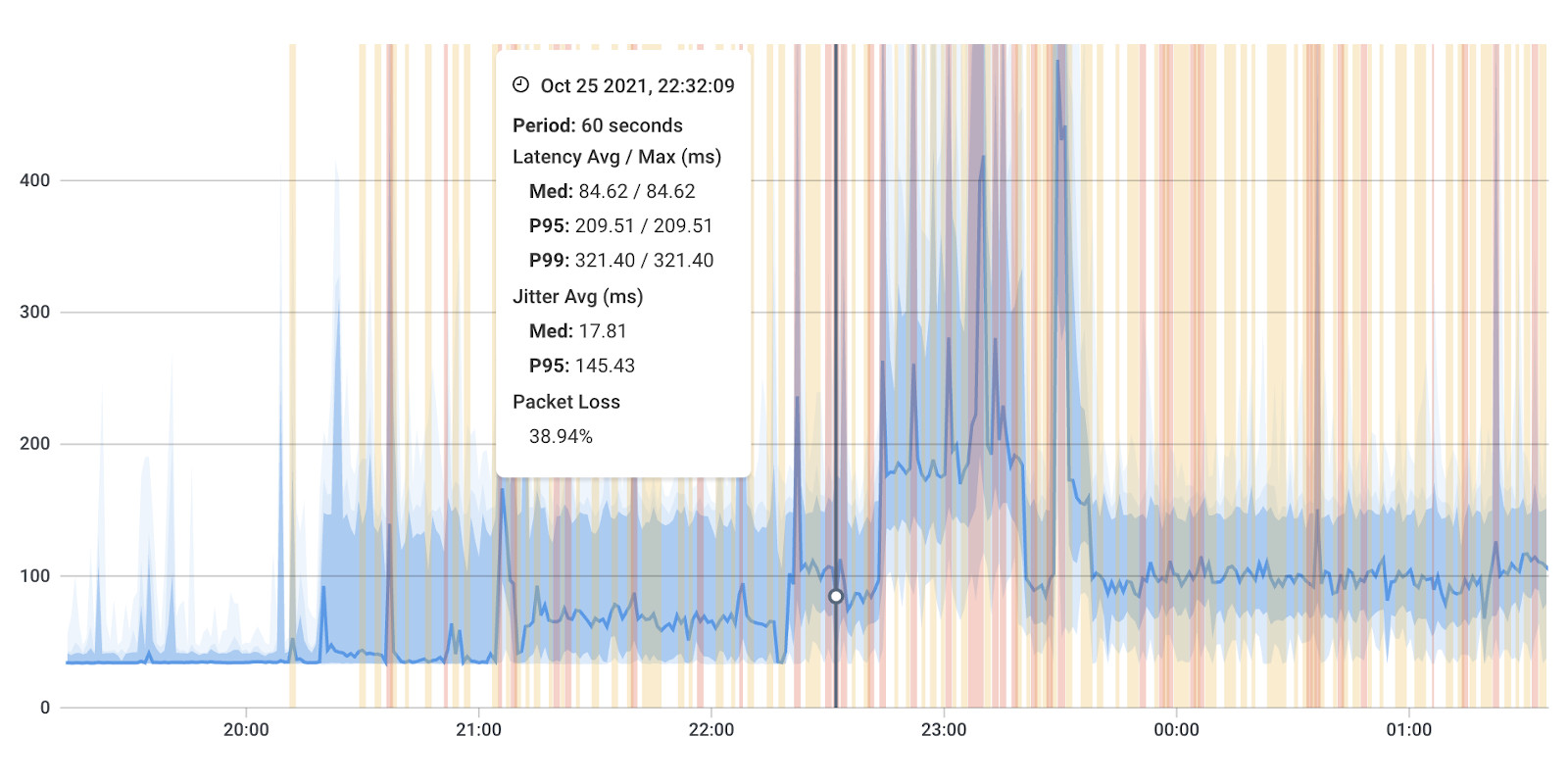

Obkio employs a more precise approach to monitor network jitter and provide timely network monitoring alerts. Rather than relying on static thresholds, Obkio utilizes historical data to determine when jitter occurs and promptly notifies you.
As soon as a deviation is detected in the historical data, indicating the presence of jitter in your network, Obkio triggers an alert to bring it to your attention.
High Sensitivity Thresholds
- Jitter Warning: 25% increase (minimum difference of 25 ms)
- Jitter Error: 50% increase (minimum difference of 50 ms)
Medium Sensitivity Thresholds
- Jitter Warning: 40% increase (minimum difference of 40 ms)
- Jitter Error: 80% increase (minimum difference of 80 ms)
Low Sensitivity Thresholds
- Jitter Warning: 60% increase (minimum difference of 60 ms)
- Jitter Error: 120% increase (minimum difference of 120 ms)
Why do we adopt this approach? The answer lies in simplicity.
Network performance is inherently measured between specific points, and the amount of jitter can vary based on factors like monitoring location and the technology used (e.g., cable, DSL, fibre). This variability would necessitate configuring different jitter thresholds for each monitoring session, which can be time-consuming and labour-intensive.
To streamline the setup process and make it more efficient, Obkio monitors network jitter based on your network's established baseline performance. This saves you the hassle of configuring multiple thresholds and simplifies the monitoring process significantly.
Step 7. Troubleshoot the Earliest Signs of Jitter - Because Just Monitoring Network Jitter Isn’t Enough
In order to effectively address network jitter issues, it is crucial to have the right tools and methodologies at your disposal. With Obkio's Network Performance Monitoring tool, troubleshooting network jitter becomes more streamlined and efficient.
In this section, let’s go over the key steps to follow when using Obkio's tool to identify and resolve jitter-related problems.
Obkio's Network Performance Monitoring tool allows you to monitor key jitter metrics in real time. Keep an eye on metrics such as round-trip time (RTT), packet delay variation (PDV), and interarrival time to identify any patterns or anomalies indicating high jitter levels.
Obkio's tool analyzes historical data to detect deviations from your network baseline. When jitter incidents occur, Obkio sends you alerts, enabling you to promptly investigate and address the issue.
Obkio's Network Performance Monitoring tool provides a detailed view of your network infrastructure. Utilize its drill-down capabilities to isolate the segments or devices experiencing high jitter. This helps you pinpoint the source of the problem and focus your troubleshooting efforts effectively.
Obkio allows you to compare network performance over different time periods. Use this feature to identify any correlation between specific events, changes in network configurations, or periods of increased network traffic with jitter occurrences. This historical comparison helps in understanding the potential causes of jitter.
At this point, you’ll want to compare your network sessions to identify if the jitter is happening in your local network or your ISP’s network. If the jitter is happening on 2 network sessions, that means that the issue is broader and affects all services and applications that depend on the network. If it’s happening on just 1 network session, this likely means that the issue is specific to the communication between your network and a particular destination, and possibly in your ISP’s network.
Obkio's tool facilitates collaboration among team members by allowing them to access and analyze network performance data. Share the relevant data and insights with your network team to collectively troubleshoot and address jitter-related issues.
Obkio offers active monitoring capabilities, allowing you to simulate traffic and monitor network performance in real time. Perform tests during different network conditions to identify how the jitter is affected and observe any correlation with specific activities or configurations.
Once the source of jitter is identified, Obkio's tool can assist in optimizing network configurations. Make use of the insights gained from the monitoring data to implement changes such as QoS policies, traffic prioritization, or network infrastructure improvements to reduce jitter and improve overall network performance.
Learn how to troubleshoot network issues by identifying where, what, why network problems occur with Network Troubleshooting tools.
Learn more

At this point, you know what’s causing the jitter in your network, when it happened, and why. By following the troubleshooting steps above, and having consulted with your internal network team or your ISP, depending on who is responsible for troubleshooting, you should also know what steps to take the fix the network jitter.
Of course, the next steps will depend on the cause of the jitter, but here are some general tips for fixing network jitter:
- Prioritize Network Traffic: Implement Quality of Service (QoS) mechanisms to prioritize time-sensitive traffic, such as VoIP or video conferencing, over less critical data. QoS for VoIP ensures that important packets receive preferential treatment and reduces the impact of jitter on real-time applications.
- Optimize Network Configuration: Review and optimize network configurations, including buffer sizes, routing protocols, and congestion control mechanisms. Adjusting these settings can help reduce latency and minimize the chances of congestion-induced jitter.
- Upgrade Network Infrastructure: Outdated or insufficient network hardware can contribute to jitter. Consider upgrading switches, routers, and cables to newer and higher-capacity models that can handle increased traffic and provide more stable connections.
- Minimize Network Congestion: Identify and address areas of network congestion. Distribute traffic evenly, add additional network links, or implement traffic engineering techniques to alleviate congestion and reduce jitter.
- Perform Bandwidth Management: Monitor and manage bandwidth usage to ensure adequate resources for critical applications. Implement bandwidth allocation or traffic shaping techniques to prevent bandwidth-intensive activities from overwhelming the network and causing jitter.
- Reduce Wireless Interference: If using wireless networks, address potential sources of interference, such as other devices operating on the same frequency or physical obstacles. Optimize wireless network settings and consider using wired connections where possible to minimize wireless-related jitter.
- Upgrade Internet Service: If you experience consistent jitter and have ruled out internal network issues, consider upgrading your internet service to a higher bandwidth or a more reliable connection type, such as fibre-optic, to ensure a stable and consistent network connection.
- Monitor and Analyze Network Performance: Utilize network monitoring tools, such as Obkio's Network Performance Monitoring tool, to continuously monitor network performance metrics, including jitter. Analyze the data to identify patterns, correlations, and potential causes of jitter, enabling you to make informed decisions and take targeted actions to resolve the issue.
- Collaborate with Network Providers: If you suspect that the jitter issue lies beyond your control, engage with your internet service provider or network equipment vendors for assistance. They can help troubleshoot the problem, identify potential issues within their infrastructure, and work towards a resolution.
At this point you may think you’re free of the network jitterbug - but you always need to keep an eye out! Network jitter can always come back, and since so many critical applications, like VoIP and Unified Communications apps, are so sensitive to jitter, you need to catch and troubleshoot the earliest signs as fast as possible.
The most proactive way to do that is by continuously monitoring network jitter.
- Early Detection of Issues: Continuous monitoring allows for the early detection of network jitter issues. By monitoring network jitter in real-time, you can identify any sudden spikes or sustained high levels of jitter promptly. This enables you to address the issue before it escalates and impacts critical applications or services.
- Proactive Troubleshooting: Continuous monitoring enables proactive troubleshooting of network jitter. By continuously observing jitter patterns and trends, you can identify potential sources or causes of jitter and take proactive measures to mitigate them. This proactive approach helps prevent network disruptions and minimizes the impact on user experience.
- Performance Optimization: Continuous monitoring provides valuable insights into network performance and jitter levels over time. By analyzing historical data, you can identify patterns, correlations, and potential optimization opportunities. This information allows you to fine-tune network configurations, allocate resources efficiently, and optimize the network for better overall performance.
- Quality of Service Assurance: Network jitter can significantly impact the quality of service for real-time applications. Continuous monitoring ensures that the network meets the required performance levels for applications such as VoIP, video conferencing, and streaming. By continuously monitoring jitter, you can guarantee a stable and reliable network environment, providing a seamless user experience for critical applications.
- Issue Identification and Isolation: Continuous monitoring helps identify and isolate network jitter issues. By continuously tracking jitter levels across different network segments, devices, or locations, you can pinpoint specific areas or components where jitter is most prominent. This information assists in troubleshooting efforts and streamlines the resolution process.
- Trend Analysis and Capacity Planning: Continuous monitoring allows for trend analysis and capacity planning. By monitoring jitter levels over an extended period, you can identify long-term trends, seasonal patterns, or growth trends that may impact network performance. This information helps in making informed decisions for capacity planning, network upgrades, or infrastructure improvements.
- Compliance and SLA Management: Continuous network jitter monitoring helps ensure compliance with service level agreements (like service or Internet SLAs) and performance requirements. By continuously monitoring jitter levels and comparing them against agreed-upon thresholds, you can track compliance and address any deviations promptly. This allows you to maintain contractual obligations and deliver a high-quality service to your customers or stakeholders.


In this article, we showed you how to deploy network jitter monitoring using Network Monitoring tools, as they give you the most complete view of your network performance, and can be used for monitoring and troubleshooting.
But before we leave you to conquer the network jitterbug, let’s briefly go over the other techniques and tools at your disposal.
NPM tools offer comprehensive monitoring capabilities, including the measurement of network jitter. These tools continuously collect and analyze network performance data, providing real-time insights into latency, packet loss, and jitter. They often use technologies like SNMP (Simple Network Management Protocol) and flow monitoring to gather data from network devices.
NMaaS providers offer cloud-based solutions that monitor network performance, including jitter, from an external perspective. These services simulate network traffic and assess performance across various locations, providing insights into network stability and identifying potential areas of improvement.
Ping and Traceroute utilities are built-in network tools that can be used to measure network latency and identify potential sources of jitter. Ping measures the round-trip time between two devices, providing an indication of network latency. Traceroute tracks the path packets take through the network, helping identify routers or network segments that introduce additional delay.
Packet capture tools, such as Wireshark, allow you to capture and analyze network traffic at a granular level. By examining packet timestamps and inter-arrival times, you can calculate jitter values and identify packets with excessive delay or variations. This method provides detailed visibility into network jitter and helps pinpoint specific issues.
Network probes, deployed strategically within a network, actively measure network performance metrics, including jitter. These probes generate synthetic traffic or simulate real-time applications to assess network conditions and detect jitter-related issues. They provide continuous monitoring and can alert administrators to potential problems.
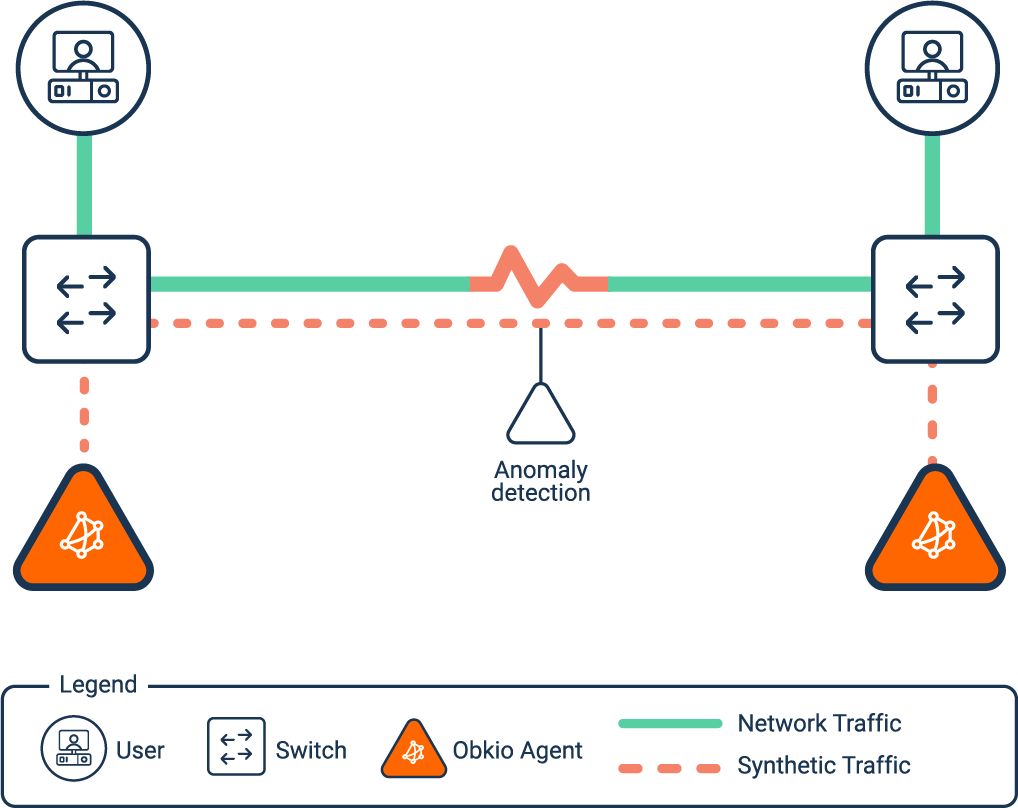
QoS monitoring focuses on measuring and managing network performance parameters to ensure a certain level of service for critical applications. By implementing QoS mechanisms, such as traffic prioritization or bandwidth allocation, administrators can mitigate jitter and maintain consistent performance. Monitoring QoS metrics can help assess the effectiveness of these mechanisms in controlling jitter.
It's important to note that the choice of monitoring technique depends on the specific needs and capabilities of your network environment. Implementing a combination of these techniques can provide a comprehensive view of network jitter and help ensure effective monitoring and troubleshooting.
In conclusion, network jitter can significantly impact the stability and performance of your network, leading to disruptions in real-time applications, compromised user experience, and decreased productivity. However, with effective network jitter monitoring, you can identify and address the underlying causes, ensuring a stable and reliable network environment.
By implementing the strategies and techniques outlined in this blog post, you can proactively troubleshoot network jitter, optimize network configurations, and take the necessary steps to mitigate jitter-related issues. Remember the importance of continuous monitoring to detect and resolve jitter problems promptly, and the significance of collaborating with reliable tools like Obkio's Network Performance Monitoring solution.

Obkio's powerful monitoring capabilities, comprehensive insights, and user-friendly interface make it an excellent choice for monitoring network jitter and maintaining network stability. Take action today by leveraging Obkio's expertise and start monitoring and optimizing your network with confidence.
Don't let network jitter hold you back—take control of your network's stability and performance with Obkio.
- 14-day free trial of all premium features
- Deploy in just 10 minutes
- Monitor performance in all key network locations
- Measure real-time network metrics
- Identify and troubleshoot live network problems



























 Obkio Blog
Obkio Blog



